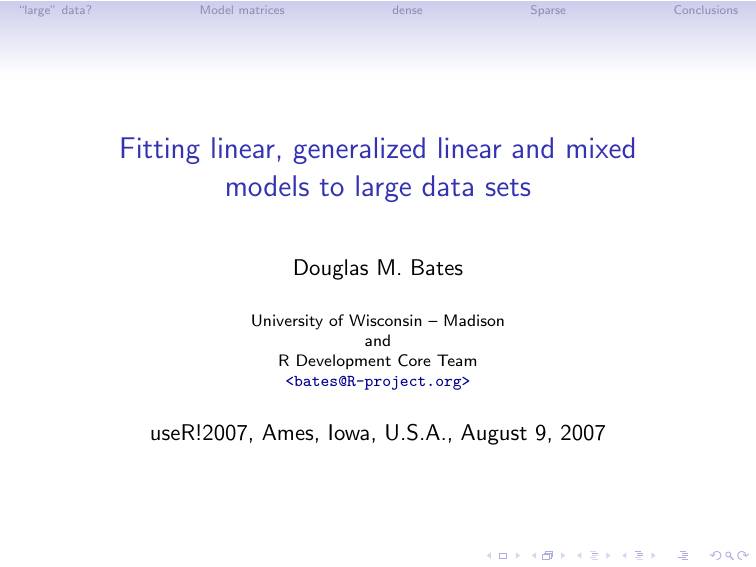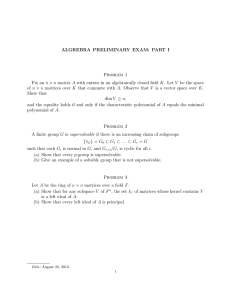Fitting linear, generalized linear and mixed models to large data sets
advertisement

“large” data? Model matrices dense Sparse Fitting linear, generalized linear and mixed models to large data sets Douglas M. Bates University of Wisconsin – Madison and R Development Core Team <bates@R-project.org> useR!2007, Ames, Iowa, U.S.A., August 9, 2007 Conclusions “large” data? Model matrices dense Outline “large” data? Model matrices Techniques with dense matrices Sparse-matrix methods Conclusions Sparse Conclusions “large” data? Model matrices dense Outline “large” data? Model matrices Techniques with dense matrices Sparse-matrix methods Conclusions Sparse Conclusions “large” data? Model matrices dense Outline “large” data? Model matrices Techniques with dense matrices Sparse-matrix methods Conclusions Sparse Conclusions “large” data? Model matrices dense Outline “large” data? Model matrices Techniques with dense matrices Sparse-matrix methods Conclusions Sparse Conclusions “large” data? Model matrices dense Outline “large” data? Model matrices Techniques with dense matrices Sparse-matrix methods Conclusions Sparse Conclusions “large” data? Model matrices dense Outline “large” data? Model matrices Techniques with dense matrices Sparse-matrix methods Conclusions Sparse Conclusions “large” data? Model matrices dense Sparse Conclusions Are my data a “large” data set? • Computing hardware and software evolves rapidly (my DVD player runs R). We must apply an evolving standard for what constitutes a “large” data set. • Your data are not large if using the naive (i.e. the “blunt instrument” or fortune(122)) approach takes less time than finding and reading the documentation that describes how to do what you want to do efficiently. • If you find that the naive approach runs out of memory or takes a long time you can • Send an email message to R-help with a subject like “R is SOOOOOO SLOOOOOOW” and vaguely describe what you are trying to do and why this software is so bad. (Do keep an asbestos suit handy for the fortune(9) response.) • Try the fortune(138) approach. “large” data? Model matrices dense Sparse Conclusions What is the effect of large data? • In short, you need to think about the computation and how it is to be done. • Early texts on statistical computing (Chambers, 1975 or Kennedy and Gentle, 1980) emphasized algorithms for numerical linear algebra, simulation, optimization, etc. paying careful attention to the time and space requirements. • In modern environments we don’t bother with “counting flops” because we realize that setting up the numerical computation often dominates the time spent actually doing the computation (fortune(98)). • Large data sets can change that balance. All that hard earned knowledge of how the cost of various operations changes with the size of the matrices involved “large” data? Model matrices dense Outline “large” data? Model matrices Techniques with dense matrices Sparse-matrix methods Conclusions Sparse Conclusions “large” data? Model matrices dense Sparse Conclusions Models and model matrices • One of the underappreciated aspects of the S language is the ability to combine a formula and a data set to produce model frame and a model matrix. It is not as trivial as it may seem. • Most operations with an n × p model matrix X and a response vector y are some form of least squares (e.g. iteratively reweighted least squares). • Everything you learned in a linear algebra class doesn’t apply to computational linear algebra. (“No, Virginia, least squares computations are not really done as (X 0 X)−1 X 0 y.”) • Numerical analysts recognize two direct decomposition methods (QR and Cholesky) for linear least squares. The time complexity is np2 for both. Space complexity is p2 for Cholesky and np for QR. (The “sweep” operator used by SAS is not even considered a contender.) “large” data? Model matrices dense Sparse Conclusions Rank deficiencies • The sweep-based method used by SAS is used because it can detect and remove rank deficiencies (in a way different from how numerical analysts would do it). • The problem of rank deficiencies occurs less frequently in the S language implementation but still frequently enough that it must be taken into consideration. This is why the QR decomposition in R is still based on Linpack, not Lapack. • Standard numerical linear algebra software doesn’t quite do things the way that statisticians want to (and numerical analysts don’t seem to want to make the necessary changes). “large” data? Model matrices dense Outline “large” data? Model matrices Techniques with dense matrices Sparse-matrix methods Conclusions Sparse Conclusions “large” data? Model matrices dense Sparse Conclusions Cholesky versus QR • The Cholesky method can be row-oriented (i.e. it can operate on horizontal sections of X and y). • The QR method is column-oriented. • In theory R provides the option of using Cholesky or QR (there is a method argument to lm.fit). In practice it only allows QR. (See previous discussion of rank deficiency.) “In theory, theory and practice are the same. In practice, they’re not.” • QR has somewhat better numerical properties than Cholesky. If this matters your X is close to rank deficient. “large” data? Model matrices dense Sparse Conclusions What can you do with existing dense matrix software? • You could work on horizontal sections of X and y (biglm package) with a Cholesky decomposition. • If you use iterative reweighting then you must store all of X somewhere or regenerate it from the model frame and the formula at each iteration. “large” data? Model matrices dense Sparse Conclusions Is n large, p moderate, or are n and p both large? • If p is getting large as n gets large, what causes p to get large? • Do you have “nuisance parameters” associated with experimental (observational) units? If so, they should probably be modeled as random effects. • If the linear predictor involves nuisance parameters, that part of the model matrix will end up being sparse. • If you model the effects of units as fixed effects you need to watch for rank deficiencies. When modeled as random effects the “shrinkage” behavior of the BLUPs provides the regularization. • For this type of data and model the combination of mixed-effects models and sparse matrix techniques is highly effective. “large” data? Model matrices dense Outline “large” data? Model matrices Techniques with dense matrices Sparse-matrix methods Conclusions Sparse Conclusions “large” data? Model matrices dense Sparse Conclusions An example ’data.frame’: 1721024 obs. of 9 variables: $ instr : Factor w/ 7964 levels "10000","10001",..: 1 1 1 1 1 1 1 1 1 $ dept : Factor w/ 106 levels "AERO","AFAM",..: 43 43 43 43 43 43 43 $ id : Factor w/ 54711 levels "900000001","900000002",..: 12152 14 $ nclass : num 40 29 33 13 47 49 37 14 21 20 ... $ vgpa : num NA NA NA NA NA NA NA NA NA NA ... $ rawai : num 2.88 -1.15 -0.08 -1.94 3.00 ... $ gr.pt : num 4 1.7 2 0 3.7 1.7 2 4 2 2.7 ... $ section : Factor w/ 70366 levels "19959 AERO011A001",..: 18417 18417 $ semester: num 19989 19989 19989 19989 19972 ... “large” data? Model matrices dense Sparse Conclusions An initial model fit > system.time(m1 <- lmer(gr.pt ~ (1|id) + (1|instr) + (1|dept), + anon.grades.df, verbose = 1)) 0: 1: 2: 3: 4: 5: 6: 7: 8: 9: 10: 11: 12: 13: 14: 15: 16: 3661278.9: 0.294219 3449897.0: 0.759218 3447850.7: 0.933685 3447432.7: 0.872045 3447415.1: 0.876286 3447413.5: 0.873344 3447413.1: 0.874789 3447412.9: 0.873407 3447412.6: 0.874738 3447399.6: 0.873381 3447382.9: 0.873987 3447380.0: 0.873637 3447379.6: 0.874317 3447379.5: 0.874401 3447379.5: 0.874153 3447379.5: 0.874185 3447379.5: 0.874191 user system elapsed 3237.977 28.393 3266.937 0.111907 0.360591 0.418499 0.462103 0.448215 0.445115 0.443935 0.443476 0.443452 0.435214 0.446658 0.440919 0.444942 0.443633 0.443656 0.443656 0.443667 0.0127038 0.862370 0.797016 0.792406 0.791340 0.790446 0.789482 0.787969 0.786346 0.665693 0.545296 0.486841 0.472003 0.475912 0.475909 0.475662 0.475346 “large” data? Model matrices dense Sparse Conclusions An initial model fit Linear mixed-effects model fit by REML Formula: gr.pt ~ (1 | id) + (1 | instr) + (1 | dept) Data: anon.grades.df AIC BIC logLik MLdeviance REMLdeviance 3447387 3447437 -1723690 3447374 3447379 Random effects: Groups Name Variance Std.Dev. id 0.3085 0.555 instr 0.0795 0.282 dept 0.0909 0.301 Residual 0.4037 0.635 Number of obs: 1685394, groups: id, 54711; instr, 7915; dept, 102 Fixed effects: Estimate Std. Error t value (Intercept) 3.1996 0.0314 102 “large” data? Model matrices dense Sparse Conclusions How can such a computation be done? • If we write a linear mixed model as b ∼ N (0, Σ), ∼ N (0, σ 2 I), b ⊥ (1) where Σ depends on a parameter θ (the three relative variance components, in the example), then Z and Σ are very sparse. y = Xβ + Zb + , • Let Σ(θ) = T (θ)S(θ)S(θ)T 0 (θ) be the “LDL” form of the Cholesky factorization of the relative variance matrix. That is, T is unit lower triangular and bmS is diagonal and on the scale of the relative standard deviation, not the variance. In our example T = I. • Let P represent the fill-reducing permutation for Z 0 Z. • For a given value of θ set V = ZT (θ)S(θ)P 0 . “large” data? Model matrices dense Sparse Conclusions The mixed model equations • We work with the Choleksy decomposition of an extended system matrix P (V 0 V + I)P 0 P V 0 X P V 0 y X 0V P 0 X 0X X 0 y = R0 R y0V P 0 y0X y0y where 0 L RV X R = 0 RX 0 0 rV y rXy . r (2) (3) • The matrices L0 and RX are upper triangular of dimension q × q and p × p respectively. The corresponding vectors, rZy and rXy , are of dimension q and p, and r is a scalar. “large” data? Model matrices dense Sparse Conclusions Profiled deviance functions • The profiled deviance function c2 (θ)|y) b − 2`(β(θ), θ, σ 2πr2 (θ) = n log + n + 2 log |L(θ)| n = n [1 + log (2π/n)] + n log r2 (θ) + 2 log |L(θ)|. (4) • The profiled REML deviance is − 2`R (θ, σ b2 (θ)|y) = (n − p) [1 + log (2π/(n − p))] + (n − p) log r2 (θ) + 2 log |L(θ)| + 2 log |RX (θ)|. (5) “large” data? Model matrices dense Sparse Conclusions An initial model fit > object.size(m1)/(2^20) [1] 747.95 > slotsz(m1)/(2^20) L 5.2332e+02 RVXy 9.5734e-01 dims 8.0872e-04 offset 3.8147e-05 Vt Zt frame flist X 6.4294e+01 6.4294e+01 4.4384e+01 2.3057e+01 1.2859e+01 1.2859 ZtXy uvec ranef call terms 9.5734e-01 4.7861e-01 4.7861e-01 2.6398e-03 2.5024e-03 9.7656 deviance cnames fixef RXy XytXy 6.2561e-04 3.6621e-04 2.5177e-04 2.2125e-04 2.2125e-04 5.3406 weights 3.8147e-05 “large” data? Model matrices dense Outline “large” data? Model matrices Techniques with dense matrices Sparse-matrix methods Conclusions Sparse Conclusions “large” data? Model matrices dense Sparse Conclusions Conclusions • There are several approaches to dealing with large data sets in R. • The fortune(122) approach is generally not terribly successful. • R is not a filter (in the sense that SAS and SPSS are). • At present the model.matrix function always outputs a full • • • • dense matrix. This is usually the point at which those working with large data sets run into trouble. It is possible, but not easy, to work with horizontal sections of the data and model matrix in the current formulation. The lmer function fits various types of mixed models using a sparse matrices but does not go through model.matrix for the sparse parts. The case of mixed models is somewhat special because grouping factors can be represented as indicators and you don’t need to watch for rank deficiencies. If both n and p are large (and if p grows with n) then







